To film breathtaking beach scenes with drones, start by choosing a high-quality drone with good wind resistance and flight time. Scout locations and plan your shots during golden hour for ideal lighting. Master essential flight techniques like tracking, reveal, and orbit shots. Adjust your camera settings for smooth motion and crisp imagery, using ND filters when needed. Capture dynamic wave patterns and showcase beach activities from unique perspectives. Pay attention to composition, using the rule of thirds and leading lines. Don't forget to follow local regulations and respect privacy. With practice and creativity, you'll soon be creating stunning aerial beach cinematography that captivates viewers.
Choosing the Right Drone
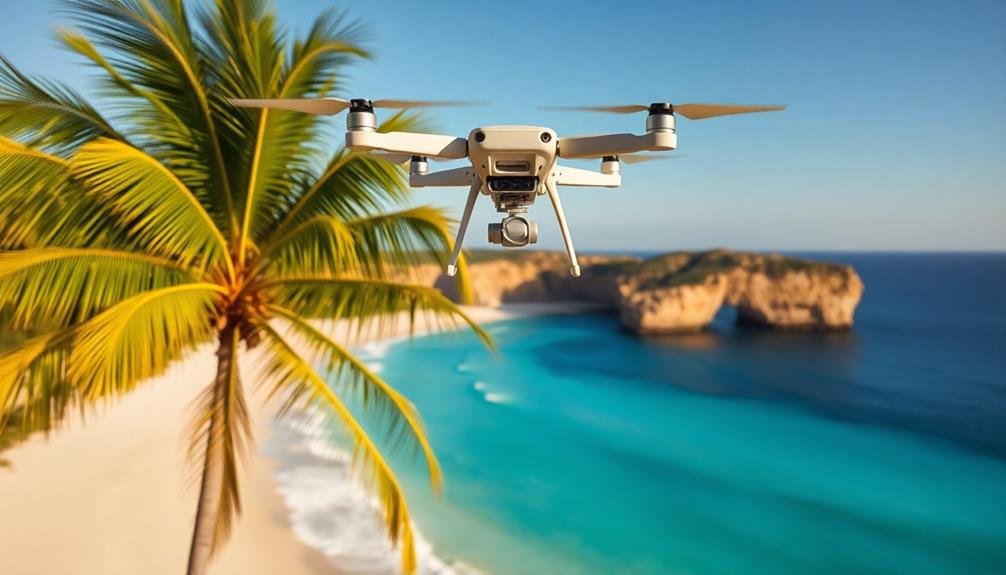
When it comes to capturing stunning beach scenes, selecting the right drone is vital. You'll want to take into account several factors to guarantee you get the best footage possible.
First, look for a drone with a high-quality camera capable of shooting 4K video and RAW photos. This will give you crisp, detailed images that really showcase the beauty of the beach.
Next, evaluate the drone's flight time and range. Beaches often offer vast expanses to explore, so you'll want a drone that can stay airborne for at least 20-30 minutes and fly several kilometers from your location.
Wind resistance is important too, as coastal areas can be gusty. Choose a drone with powerful motors and stability features to maintain smooth footage in breezy conditions.
Don't forget about portability. A compact, foldable drone is ideal for beach trips, as it's easy to pack and transport.
Finally, look for a drone with intelligent flight modes like tracking, orbit, and waypoints. These features will help you capture dynamic shots and cinematic movements without complex piloting skills.
With the right drone, you'll be well-equipped to film breathtaking beach scenes.
Beach Safety and Regulations
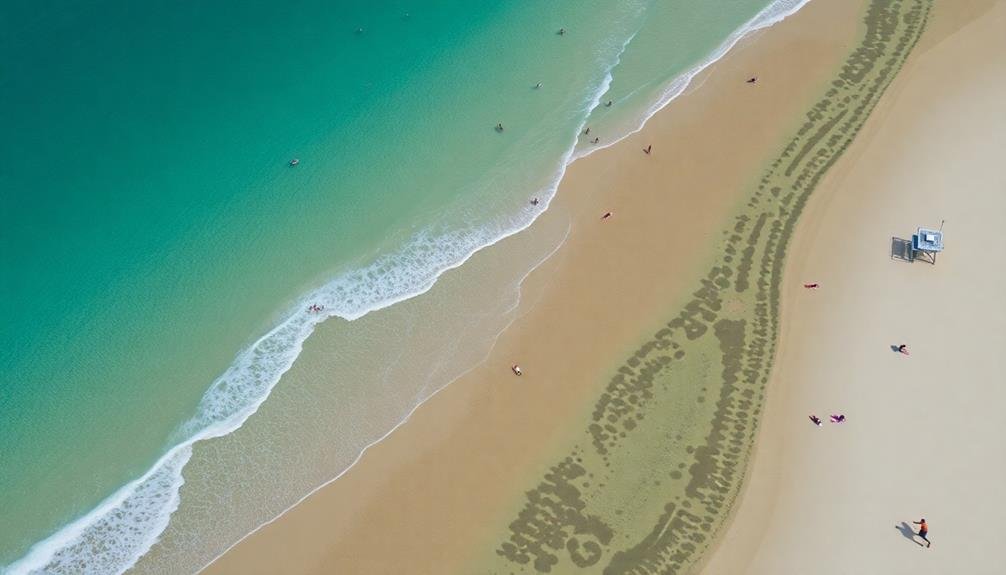
Now that you've selected the perfect drone for your beach cinematography, it's important to understand the safety measures and regulations surrounding drone use in coastal areas. Always check local laws and obtain necessary permits before flying. Keep your drone within visual line of sight and avoid flying over people or wildlife. Be aware of no-fly zones, such as protected areas or military installations.
When operating near the coast, consider these key factors:
| Weather | Environment | Safety |
|---|---|---|
| Wind speed | Sand exposure | Maintain distance |
| Visibility | Salt water | Avoid crowded areas |
| Temperature | Sunlight glare | Watch for birds |
| Humidity | Magnetic interference | Emergency landing spots |
Pay attention to weather conditions, as strong winds and sudden gusts can affect your drone's stability. Protect your equipment from sand and saltwater, which can damage sensitive components. Always prioritize safety by maintaining a safe distance from people, wildlife, and structures. Be prepared for unexpected situations by identifying potential emergency landing spots. Finally, respect the privacy of beachgoers and follow ethical guidelines when capturing footage. By adhering to these regulations and safety measures, you'll guarantee a smooth and responsible drone filming experience on the beach.
Best Times for Beach Filming
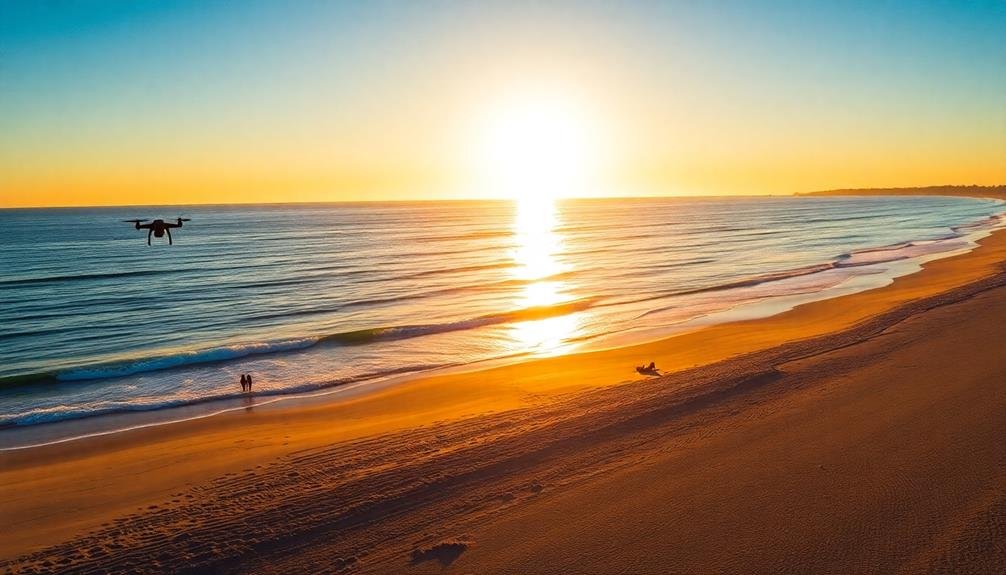
When filming beach scenes with drones, you'll want to capitalize on the Golden Hour's magic.
This period just after sunrise or before sunset bathes the landscape in warm, soft light, creating stunning visuals.
You'll also need to take into account tidal patterns, as low tide can reveal interesting rock formations or tidal pools, while high tide might offer dramatic wave action for your shots.
Golden Hour Magic
Many drone operators consider the golden hour the crown jewel of beach filming times. This magical period occurs twice daily, just after sunrise and before sunset, when the sun's low position casts a warm, golden light across the landscape.
During these fleeting moments, you'll capture stunning footage with long shadows, vibrant colors, and a soft, ethereal glow.
To make the most of golden hour, arrive early and set up your equipment. Scout locations beforehand to identify compelling compositions.
As you film, experiment with different angles and altitudes to showcase the interplay of light and shadow on the sand, water, and any coastal features. Don't forget to adjust your camera settings to accommodate the changing light conditions.
Keep in mind that golden hour's duration varies depending on your location and the time of year. In some places, it may last only 20-30 minutes, while in others, you might've up to an hour.
Plan accordingly and be prepared to work quickly. Remember, the light changes rapidly during this time, so be ready to adapt your shots as the sun's position shifts.
With careful planning and execution, you'll capture breathtaking beach scenes that truly shine.
Tidal Considerations
While golden hour offers stunning lighting conditions, understanding tidal patterns is equally significant for capturing the perfect beach scenes. Tides can dramatically alter the landscape, exposing hidden features or submerging picturesque sandbanks. To make the most of tidal variations, you'll need to plan your drone flights carefully.
Research local tide tables and aim to film during low tide for expansive beach shots. This is when you'll find exposed rock formations, tidal pools, and intricate sand patterns. Conversely, high tide can create stunning reflections and waves crashing against cliffs or seawalls.
Here are four key considerations for tidal drone filming:
- Safety first: Always check weather conditions and avoid flying during strong winds or storms.
- Timing is essential: Arrive at least an hour before your intended filming time to set up and scout locations.
- Battery life: Factor in the time needed for multiple flights to capture different tidal stages.
- Composition: Use tidal changes to your advantage, framing shots that showcase the dynamic nature of the coastline.
Mastering Flight Techniques
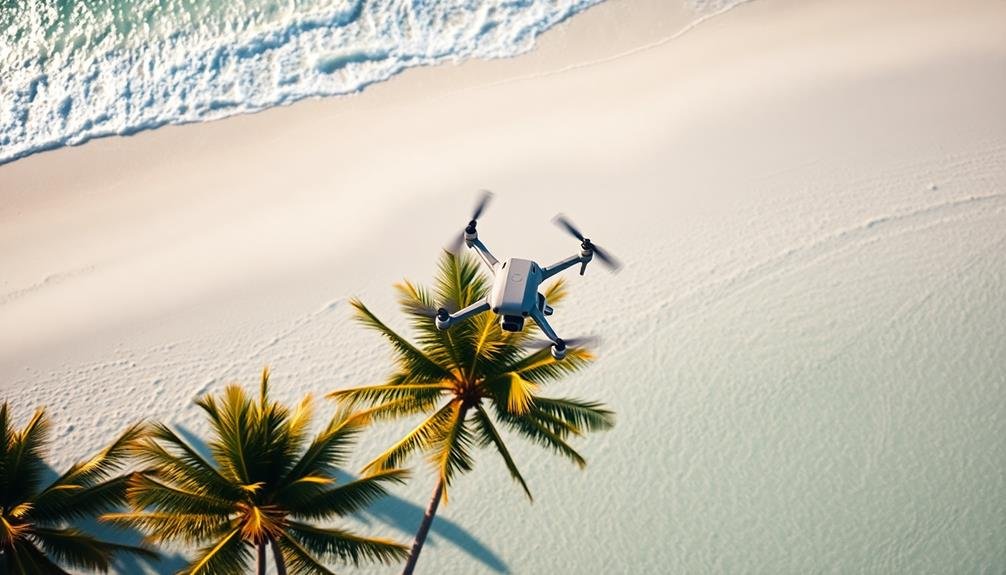
Drone pilots must hone their skills to capture stunning beach footage. You'll need to master various flight techniques to create cinematic shots that truly showcase the beauty of coastal landscapes. Focus on perfecting these essential maneuvers:
| Technique | Purpose |
|---|---|
| Tracking shots | Follow subjects along the shoreline |
| Reveal shots | Disclose scenery by ascending or descending |
| Orbit shots | Circle around points of interest |
| Dolly shots | Move laterally for dynamic compositions |
| Altitude shifts | Change perspective for dramatic effect |
Practice these techniques regularly to improve your control and precision. You'll want to maintain smooth, steady movements to avoid jarring changes in your footage. Start with slower speeds and gradually increase as you become more comfortable with your drone's handling.
Don't forget to experiment with different angles and heights. Low-altitude flights can capture intimate details of waves and sand patterns, while high-altitude shots provide breathtaking panoramic views. Combine these techniques to create a diverse and engaging visual narrative of the beach environment.
Remember to always prioritize safety and adhere to local regulations when flying your drone near coastal areas.
Ideal Camera Settings
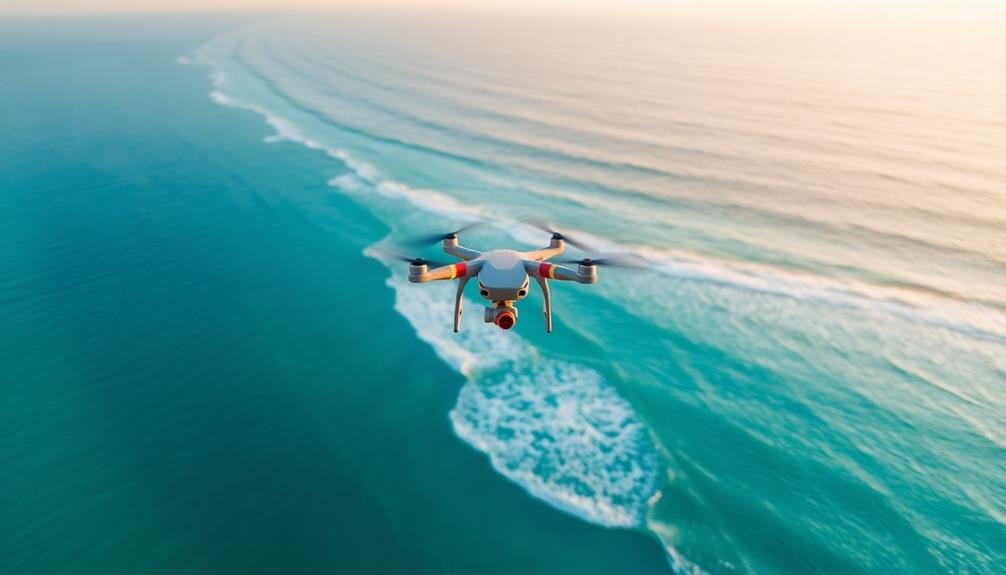
Once you've mastered your flight techniques, it's crucial to optimize your camera settings for beach cinematography. Proper camera settings can make the difference between amateur footage and stunning, professional-quality shots. Start by setting your camera to manual mode, giving you full control over exposure, shutter speed, and ISO.
For beach scenes, consider these key settings:
- Shutter speed: Aim for 1/60th to 1/120th of a second to capture smooth motion while maintaining crisp details.
- Aperture: Use a smaller aperture (f/8 to f/11) for wider depth of field, ensuring both foreground and background elements are in focus.
- ISO: Keep it low (100-400) to minimize noise and maintain image quality, especially in bright beach conditions.
- White balance: Set to "Daylight" or "Sunny" to accurately capture the warm tones of sand and sea.
Don't forget to shoot in RAW format for maximum flexibility in post-processing.
Experiment with different frame rates to achieve varying effects, such as slow-motion for dramatic wave shots.
Remember to adjust your ND filters as needed to maintain proper exposure in changing light conditions.
With these settings optimized, you'll be well-equipped to capture breathtaking beach scenes from the air.
Composition for Aerial Beach Shots
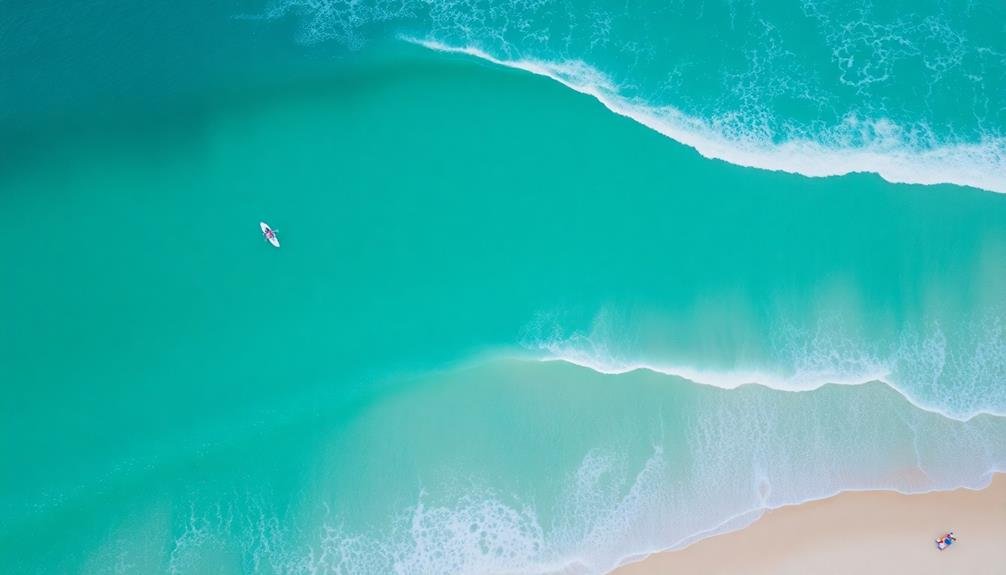
When composing aerial beach shots, you'll want to apply classic photography principles to your drone footage.
Utilize the rule of thirds by positioning key elements along imaginary grid lines to create balanced and visually appealing frames.
Additionally, you can enhance your compositions by identifying and incorporating leading lines, such as shorelines, paths, or waves, to guide viewers' eyes through your scenic beach shots.
Rule of Thirds
For stunning aerial beach compositions, the rule of thirds is your secret weapon. This principle divides your frame into a 3×3 grid, creating intersection points that naturally draw the viewer's eye. When filming beach scenes with your drone, use these points to position key elements for maximum visual impact.
To effectively apply the rule of thirds in your aerial beach shots:
- Place the horizon along the top or bottom horizontal line, depending on whether you want to emphasize the sky or the beach.
- Position interesting features, such as rock formations or boats, at the intersection points of the grid lines.
- Use the vertical lines to frame coastal elements like cliffs, piers, or shorelines.
- Leave space in the direction of movement for subjects like surfers or waves, placing them on the opposite third of the frame.
Leading Lines Techniques
Leading lines are a powerful compositional tool that can elevate your aerial beach photography to new heights. When filming with drones, you'll find that beaches offer a wealth of natural leading lines to guide your viewers' eyes through the frame.
Look for elements like shorelines, waves, sand patterns, and coastal roads to create compelling compositions. You can use these lines to draw attention to your main subject or to create a sense of depth and perspective in your shots. Experiment with different angles and altitudes to find the most striking leading lines.
Here's a table showcasing various leading line elements and their effects:
| Element | Direction | Effect | Best Altitude |
|---|---|---|---|
| Shoreline | Horizontal | Calm, expansive | Medium-high |
| Waves | Diagonal | Dynamic, energetic | Low-medium |
| Sand patterns | Curved | Organic, flowing | Low |
| Coastal road | Straight | Direct, purposeful | High |
Remember to adjust your drone's camera settings to enhance the visibility of leading lines. Increase contrast and sharpness to make these elements pop. By mastering leading lines techniques, you'll create visually stunning aerial beach footage that captivates your audience.
Capturing Wave Patterns
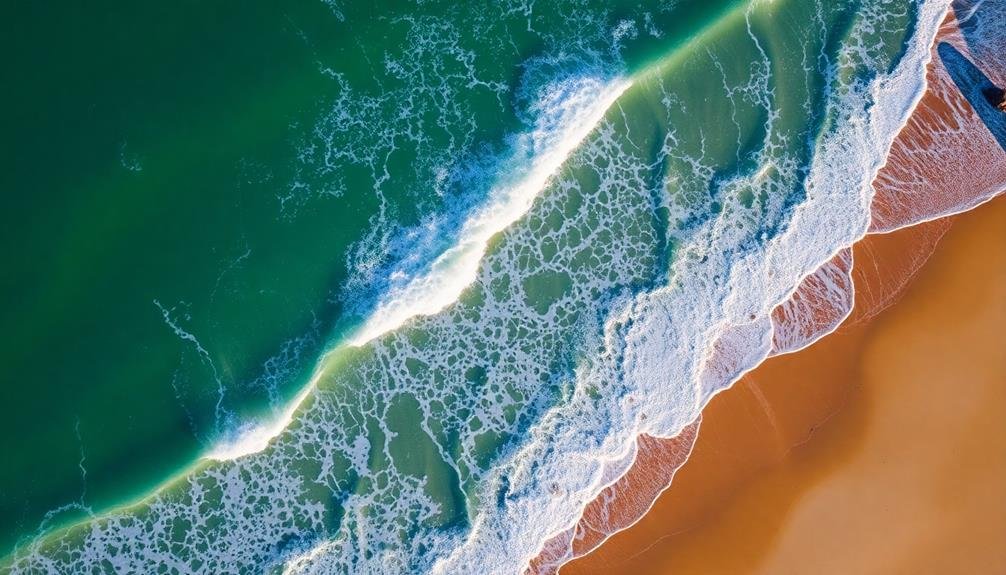
Waves, the ocean's mesmerizing rhythm, offer endless opportunities for stunning drone footage. To capture their patterns effectively, you'll need to master a few key techniques. First, timing is vital. Arrive during low tide when wave patterns are more visible and pronounced. You'll want to fly your drone at different altitudes to experiment with various perspectives.
When filming wave patterns, consider these four essential tips:
- Use slow, sweeping movements to showcase the waves' natural flow
- Experiment with different angles, including top-down and side views
- Capture the contrast between breaking waves and calm water
- Look for unique formations like spirals or zigzags in the wave patterns
Don't forget to adjust your camera settings for ideal results. Use a faster shutter speed to freeze the motion of individual waves, or slow it down for a dreamy, ethereal effect.
Pay attention to the sunlight's angle, as it can create stunning reflections and shadows on the water's surface. If you're filming during golden hour, you'll capture warm, glowing hues that enhance the beauty of the wave patterns.
Showcasing Beach Activities
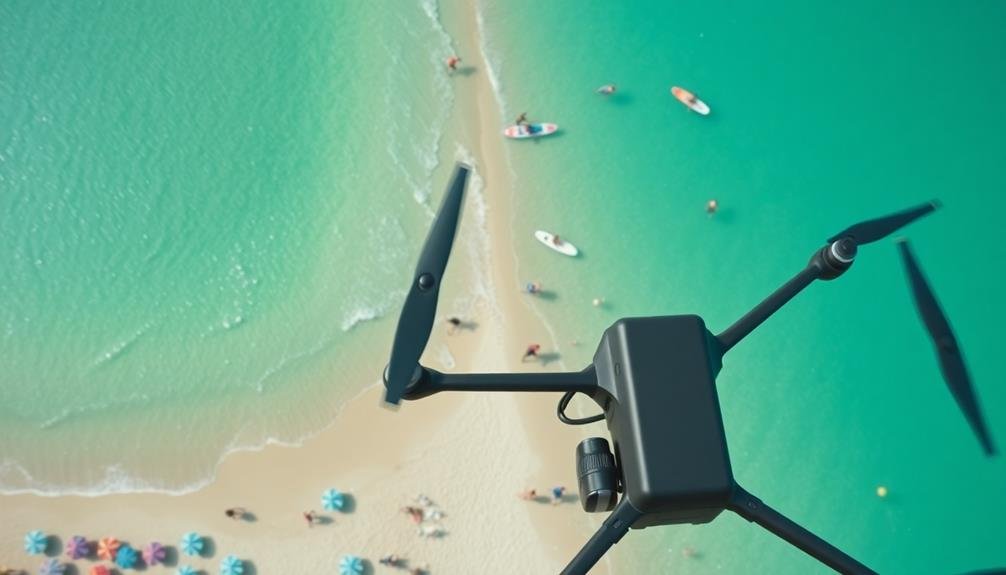
You'll find endless opportunities to capture dynamic beach activities with your drone.
Focus on water sports enthusiasts riding waves or windsurfing to showcase high-energy action.
For a more relaxed vibe, frame sunbathers, beach volleyball players, or families building sandcastles to highlight the diverse leisure activities along the shoreline.
Capture Water Sports Action
Exhilaration defines water sports, and drone footage can capture this excitement like never before. When filming water sports action with your drone, you'll want to focus on the dynamic movements and splashing water that make these activities so thrilling.
Position your drone to capture wide shots of surfers riding waves, windsurfers catching air, or jet skiers carving through the water.
To get the best water sports footage, follow these tips:
- Use tracking modes to follow fast-moving subjects automatically
- Experiment with different angles, including top-down views and low-altitude shots
- Adjust your camera settings for higher frame rates to capture smooth slow-motion footage
- Time your shots to coincide with big waves or impressive stunts
Don't forget to showcase the interaction between the athletes and the water. Capture the spray from a wakeboarder's turn or the moment a kiteboarder launches into the air.
By varying your shots and focusing on the most exciting moments, you'll create a dynamic and engaging video that truly captures the thrill of water sports.
Remember to always prioritize safety and follow local regulations when flying your drone near water activities.
Frame Beachgoers' Leisurely Moments
While capturing high-energy water sports is thrilling, don't overlook the quieter moments that make beach life so appealing. Use your drone to frame beachgoers enjoying leisurely activities, creating a more relaxed and intimate perspective of the shoreline.
Fly your drone at a moderate altitude to capture groups of sunbathers, families building sandcastles, or friends playing beach volleyball. Look for interesting patterns created by beach umbrellas and towels spread across the sand. Experiment with different angles to showcase the contrast between the colorful beachgoers and the natural hues of sand and sea.
For a unique view, try flying your drone parallel to the shoreline at a low altitude. This technique allows you to capture people strolling along the water's edge or collecting seashells. You can also use your drone to follow a couple on a romantic beach walk, creating a cinematic sequence.
Don't forget to capture the golden hour, when the sun's warm light bathes the beach in a soft glow. This time of day is perfect for framing silhouettes of people against the sunset or highlighting the tranquil atmosphere as beachgoers wind down their day.
Post-Processing Beach Footage
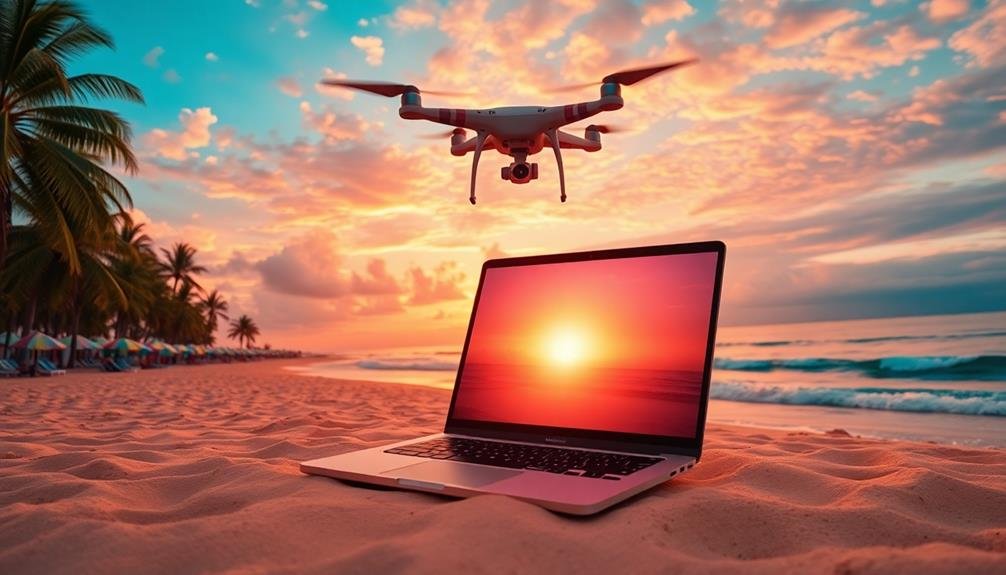
The editing room is where your beach drone footage truly comes to life. You'll need to carefully select the best shots, adjust colors, and create a fascinating narrative to showcase the beauty of the coastline.
Start by organizing your footage and identifying the most stunning sequences that highlight the beach's unique features.
Color grading is essential for beach scenes. Enhance the blues of the ocean and sky, bring out the golden hues of the sand, and adjust contrast to make the landscape pop.
Don't overdo it, though – aim for a natural look that captures the authentic beauty of the location.
To create a compelling final product, consider these post-processing techniques:
- Use smooth shifts between shots to maintain flow
- Add slow-motion effects to emphasize graceful movements of waves or wildlife
- Incorporate dynamic zooms or pans to reveal expansive vistas
- Layer in ambient sounds of waves and seabirds for immersion
Storytelling Through Drone Beach Cinematography
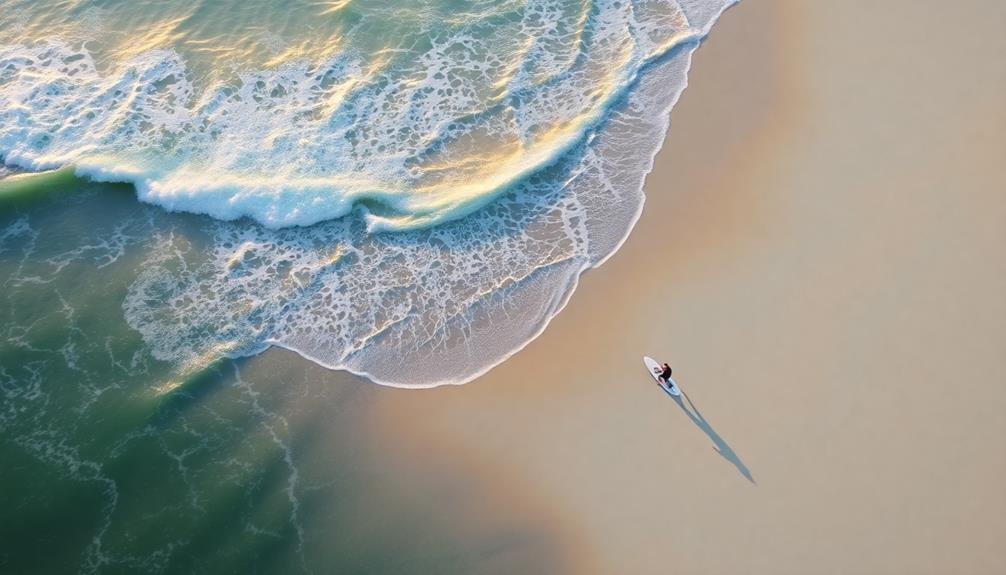
Drone cinematography offers unique opportunities to tell compelling stories about beaches and coastal environments. You can use aerial shots to establish the vastness of the ocean, the curve of the shoreline, and the relationship between land and sea.
Start with wide establishing shots to set the scene, then gradually move closer to capture more intimate details.
Think about the story you want to tell. Is it about the beauty of nature, human interaction with the environment, or the passage of time? Use your drone's movement to guide the viewer's eye and create a narrative flow. Slow, sweeping motions can convey serenity, while faster movements might suggest energy or urgency.
Don't forget to include human elements to add scale and relatability. Capture beachgoers, surfers, or boats to provide context and interest. Experiment with different altitudes and angles to reveal unique perspectives. Try flying low over the water's surface or high above the beach to show patterns in the sand and waves.
Remember to respect local regulations and wildlife. Your storytelling should enhance, not disturb, the natural beauty of the beach environment.
Frequently Asked Questions
How Do I Prevent Sand From Damaging My Drone During Beach Flights?
To protect your drone from sand damage during beach flights, you'll want to keep it elevated when taking off and landing. Use a launch pad, clean it after each flight, and avoid flying in strong winds that kick up sand.
What Are the Best Waterproof Cases for Transporting Drones to Beaches?
You'll want to contemplate hard-shell waterproof cases from brands like Pelican or Nanuk. They're durable, customizable, and offer excellent protection. Don't forget to look for cases with foam inserts that you can tailor to your specific drone model.
How Can I Minimize Glare From the Sun on Water Surfaces?
To minimize glare on water surfaces, you'll want to use a polarizing filter on your drone's camera. It'll reduce reflections and enhance colors. Try shooting during golden hour or when the sun's at an angle for best results.
Are There Special Considerations for Filming Beaches in Different Climate Zones?
Yes, you'll need to adapt to different climate zones. Consider lighting conditions, weather patterns, and local regulations. In tropical areas, watch for humidity affecting your equipment. In colder regions, prepare for wind and potential snow coverage.
How Do I Capture Underwater Scenes Seamlessly With My Aerial Beach Footage?
You'll need a waterproof drone or separate underwater camera. Shift smoothly by flying low over the water, then dipping below. Match color grading and lighting between aerial and underwater shots for a seamless blend in post-production.
In Summary
You've now got the tools to create stunning beach drone footage. Remember to prioritize safety, respect regulations, and master your flight skills. Experiment with different times of day, camera settings, and angles to capture the beach's unique beauty. Focus on wave patterns and beach activities to add life to your shots. With practice and creativity, you'll tell enchanting stories through your aerial beach cinematography. Now go out there and make some waves!

As educators and advocates for responsible drone use, we’re committed to sharing our knowledge and expertise with aspiring aerial photographers.
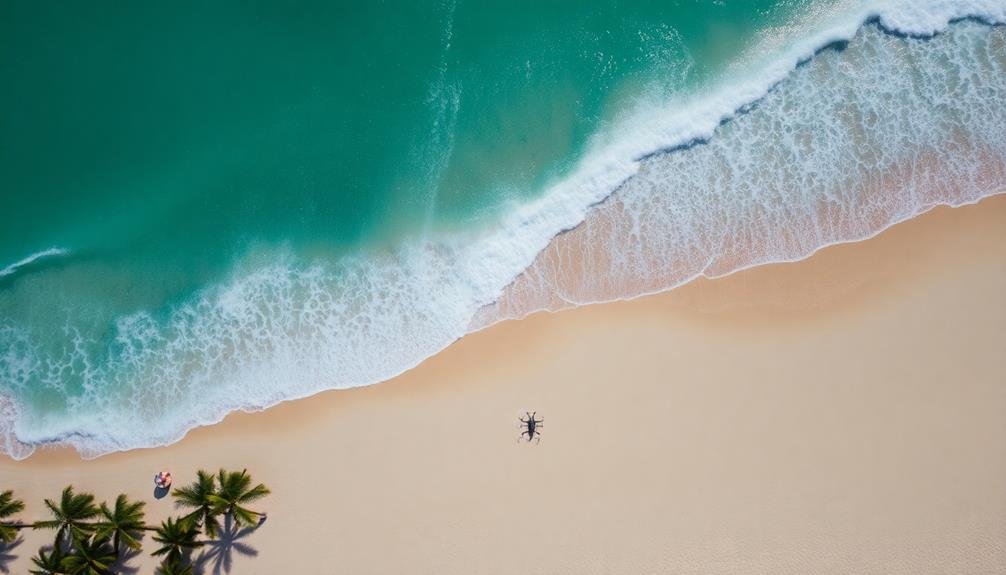



Leave a Reply